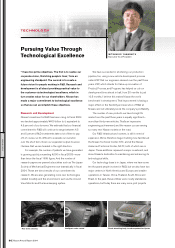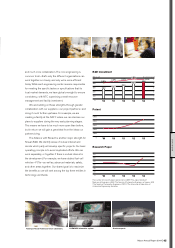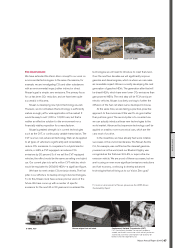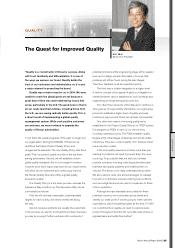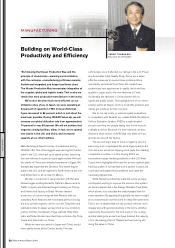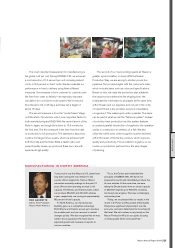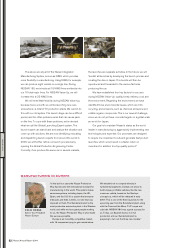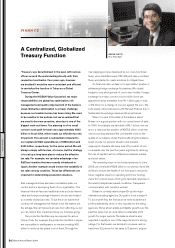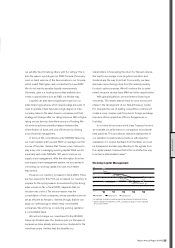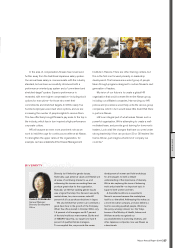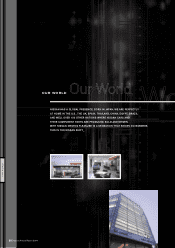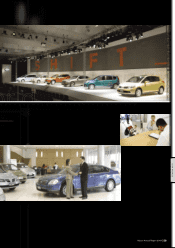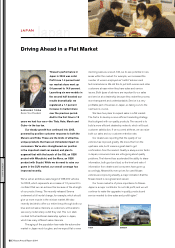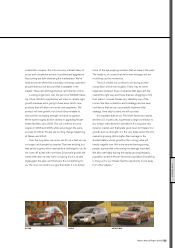Nissan 2005 Annual Report Download - page 55
Download and view the complete annual report
Please find page 55 of the 2005 Nissan annual report below. You can navigate through the pages in the report by either clicking on the pages listed below, or by using the keyword search tool below to find specific information within the annual report.
Nissan Annual Report 2004 53
Control is also responsible for managing investments,
an area of major concern to all stakeholders. Our
investment decisions are based on profitability criteria. We
have made sound investments in our product lineup, R&D,
manufacturing capacity, and overseas operations. In fiscal
year 2004, for example, our R&D expenditures were at 4.6
percent of turnover, which is in line with that of other
Japanese carmakers. In years past, Nissan was slow in
making the necessary investments in this field, and R&D
suffered as a result. To reestablish our technological
advantage and secure sustainable growth, we upgraded
our R&D capabilities. Nissan’s revival—along with the
success of our lineup and our industry-leading operating
margin over the past three years—are all evidence that the
decision was the right one.
Our overseas expansion provides another example of
investment decisions based on profitability. Recently, we
invested in China and Thailand to enlarge our markets and
develop production capacity in these new competitive
countries. Despite the risks associated with these markets,
we were profitable in our first year of operations. Few
companies have been able to do this.
In reviewing operations, we also monitor general and
administrative costs and sales and marketing expenses.
Sales and marketing expenses are of importance, as they
illustrate our capability to manage the relationship between
volume objectives and profitability. In North America,
incentives for the Nissan and Infiniti brands are at the
lowest end of the market, yet global retail sales volumes
are up 22 percent over the past three years. We have
successfully fought market pressures and kept incentives
low, while greatly increasing sales.
Control’s overall mission is to support management in
achieving the objectives set forth in NISSAN Value-Up.
Although Nissan is a healthy company, we do not perceive
ourselves as cash-rich when considering an investment.
Control ensures that management decisions are based on
creating value and meeting shareholder expectations.”
CONTROL
“Control oversees the entire Group’s performance, and we
measure that performance by what our shareholders expect
as a return on their investment. Our primary role, therefore,
is to ensure the creation of value. This is measured by
operating profit, net income after tax, net present value of
investments, and return on invested capital.
We help to set global objectives and then to create the
model used to achieve them. At present, Control is
committed to the objectives of the NISSAN Value-Up
plan—deliver a top-level operating profit margin among
global automakers in fiscal 2005-07, 4.2 millions units in
fiscal 2008, and a 20 percent average ROIC over the
course of the plan. Our task is to validate the resources
required to achieve these objectives.
We also monitor the performance of each function,
region and product relative to its respective objectives.
To make that process work, we have controllers for every
function and region. These controllers have two main
responsibilities. The first is to monitor, challenge and
support operations at the function, region and product
levels. The second is to deliver financial information on
Nissan’s profitability and manage risks and opportunities.
In addition to implementing and monitoring the annual
objectives for each area, Control also oversees the budget
and investment control processes.
The annual budget is based on the objectives of the
three-year NISSAN Value-Up plan. It is devised to ensure
consistency across the whole complex weave of our
products, regions and functions. Once the budget is
approved, we analyze and compare actual results to it on
a monthly basis. This maintains adherence to the NISSAN
Value-Up plan. To enhance management’s understanding
of the Group’s overall performance, Control forecasts
performance trends three times a year. As precisely and
accurately as possible, we try to predict what will happen in
the immediate future so we can see what needs to be done
in the coming months. Control also strives to identify and
mitigate risks and maximize benefits if opportunities arise.
Decisions Based on
Shareholder Expectations ALAIN-PIERRE RAYNAUD
Senior Vice President
OUR WORK



